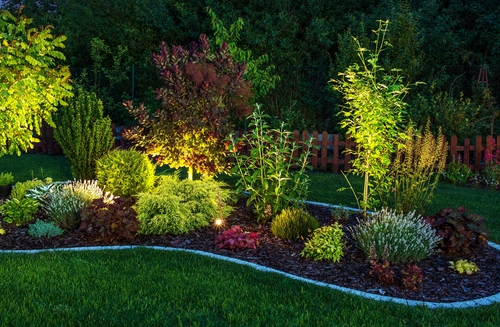Posts Tagged landscape
How To Find A Good Landscaper in Rohnert Park
As per the survey conducted by the National Association of Landscape Professionals, 67% of Americans agree that professional landscaping allows them to have beautiful yards. You, too, want an inviting yard and outdoor space. However, the challenge is finding the right landscaper. In this article, you will find out how to find a good landscaper Rohnert Park.
Identify what you want

There are different types of landscapers. Each specializes in different things. Some specialize in lawn installation and maintenance. Others, solely do gardening. While others offer full-range services, including landscape design.
After identifying what you want, you can know what type of landscaper to look for.
Research local landscapers
First, go to Google and search for landscaper Rohnert Park. You want to find landscapers that provide their services in your area.
Make a list of landscapers you could potentially hire. Then compare them. Compare services offered, price, and reputation.
Reputation is vital as you want to hire a company that provides quality services. So, look for reviews of the company on sites such as Yelp, BBB (Better Business Bureau), and Angie’s List. Also, check the landscaper’s website for testimonials or ask them for referrals.
Request quotes
At this point, you have identified a few (2 to 3) landscapers you consider best suited to handle your project. Go ahead and ask for quotes. Most landscapers will prefer to come and see the scope of the project before they can provide an estimate.
This one-on-one meeting is an opportunity to vet them further. As much as the budget is essential, it should not be your sole focus. Ask about:
- Insurance: you do not want to be liable to injuries to the people working in your property.
- Completion timetable: Landscapers often have multiple clients, and a company might delay your work as they are already engaged in several other projects.
- Guarantees: A good landscaping company will offer at least a 2-year guarantee on their work.
- How they will handle your project: By asking this question, you get to gauge how experienced and knowledgeable a contractor is.
Consider their personality traits
You don’t just need a landscaper with the right skills and qualifications. You need one that will understand what you need and work with you to make your dream yard come true. So, as you talk to them, look for the following personality traits:
- Excellent communication: You want a contractor that explains the processes and work involved clearly.
- Patience: A patient contractor will not only listen and but also understand your needs.
- Willingness to work with your ideas
- Creativity: so that they can improve your ideas
Do you need a landscaper Rohnert Park? Contact us today. We specialize in landscape repair and maintenance and irrigation. We are also specialists in xeriscape or water-saving landscape design.
How and When to use Fertilizer in Your Lawn and Garden
Time for our annual reminder that fall is one of the best times to apply fertilizer to your lawn. Why? Because a proper application of fertilizer before the first frost will help it survive a harsh winter. Certain plants such as pansies, Iceland poppies, and calendula, usually need to be fertilized now, too, because most soil doesn’t provide the essential nutrients they need for optimum growth.
Guide to Healthy Lawns

Sonoma County is home to more than a dozen grass species. These cool-season grasses actively grow in the spring and fall. That’s why it’s important to fertilizer during those times of years. Experts recommend that at least one fertilizer treatment be a “complete” one that includes all three primary nutrients a healthy lawn needs: nitrogen, phosphorus, and potassium. Otherwise, most established lawns need only a nitrogen rich treatment on a regular basis.
Some signs that your lawn needs fertilization include:
- Discoloration
- Slow growth
- Weed or other pest invasion
The key to a health lawn is making sure just the right amount of fertilizer is applied over the course of a year. Too little and you have the problems listed above; too much and root growth slows down, leaving your lawn vulnerable to problems like insect infestation.
Fertilizer as Part of Regular Landscape Maintenance
A lush, green lawn depends on more than watering and mowing. It’s the result of regular, strategic maintenance throughout the year. DK Landscaping’s innovative lawn maintenance plan helps your yard stand out in the neighborhood.
From streetscapes and business complexes to condos and single-family homes, DK Landscaping delivers consistent, reliable landscape maintenance services to local properties. Any business or homeowner who wants to protect their investment should consider using a service like ours that gets a landscape on a regular maintenance schedule.
Helping our commercial and residential customers enhance their landscape is a vital part of what we do. We know the best time to fertilize, what spot treatments are needed, and when it’s the best time to uproot weeds, aerate, mow, and mulch. We want to help you get and keep a healthy and beautiful lawn!
As professional landscapers we also provide monthly irrigation inspections to help you manage your water use and save money while doing it. Other maintenance services include:
- pH test to check for proper nourishment
- Tree care including trimming, planting, moving, disease control, and removal
- Seasonal color plantings
- Garden bed care including pruning, weeding, fertilizing, and mulching
Learn More
Want to learn more about keeping your lawn in prime condition through the use of fertilizer? Contact us today. We look forward to discussing with you all the benefits of getting on a regular landscape maintenance schedule!
Landscape Maintenance: Simple Guidelines for Reducing Your Long-Term Costs
Beautiful and pristine landscapes enhance the general appeal of homes. In addition, landscape maintenance can increase the resale value of the property. Unfortunately, the cost of keeping your lawn, garden and other landscaping features in excellent condition can be high. As a result, it is not uncommon for homeowners to neglect this aspect of their real property. If you are struggling with keeping up with these expenses, you might be looking for a way to minimize costs without sacrificing your beautiful landscape. Here are simple maintenance tips to help you improve your landscape at lower costs.
Choose Low-Maintenance Plants

Your choice of plants will determine the level of maintenance required to keep your property in the best condition. In simple terms, some types of grasses, flowers, shrubs and trees need more intensive care to grow and thrive. If you have these high level upkeep plants, you will need to spend more water, fertilizer and labor on your landscape. Therefore, if you are planning on adding some fresh flowers or other plants to your landscape, opt for hardy plants. For instance, drought-resistant and indigenous plants will grow naturally without special care or high costs.
Remove Invasive Weeds
It is important to keep an eye on the weeds growing on your landscape. In general, invasive weeds are quite harmful to your decorative flora and the lawn. The unwanted plants tend to compete for nutrients and often cause the malnourishment of your valuable landscaping plants. Therefore, you should check your lawn periodically for weeds and remove them. This task is relatively easy and does not require special equipment. You can manually uproot the invasive species or use hoes or weeders. If your lawn is heavily affected, herbicides are also an option.
Consider the Composting Option
Landscaping plants need additional nutrients to thrive because the natural soil has limited nutrients. In general, homeowners purchase fertilizer and other enriching solutions from local stores and landscaping companies. Commercial products are convenient because they are readymade, easy to apply and well-balanced. However, this is not your only option. It is possible to create your own nutritional material by composting your green waste. This solution is viable if you have plenty of green waste and time to handle the composting process. The compost will enrich and improve the composition of the soil, and you will save on landscape maintenance costs.
Establish a Suitable Watering Routine
Residential lawns and gardens require regular watering for ideal growth. Unfortunately, numerous people spend more money than necessary on irrigation. This issue can be attributed to irresponsible watering practices. It is important to have a good plan to minimize water wastage. Where possible, it is advisable to place programmable sprinklers on your property. These devices will release water at predetermined intervals. Also, you should plan for watering in the mornings so that the water will not be wasted through evaporation.
Professional Landscape Maintenance
Landscape maintenance can be a time-consuming process. In addition, if you are not familiar with the work, you might not get the best results. Therefore, if you have insufficient time or have never dealt with the upkeep tasks in the past, consider professional landscape maintenance. The investment is worthwhile because you will avoid damaging your land. Also, it is cheaper to have an expert handle the work than causing damage and planning for restoration.
If you would like to learn more about professional landscape maintenance and possible money-saving tips, consult our experienced landscaping experts for information.
Landscaping Guide: How to Create a Beautiful and Functional Garden Design
There is no perfect garden design for all properties. Therefore, if you are interested in improving your landscape by establishing a garden, you must create a custom design that matches your needs. We at DK Landscaping know that an ideal design should complement the unique aspects of your property. Each piece of land has idiosyncrasies which can be used in landscaping. In addition, you must think about your goals for your new garden. Here are some simple guidelines to help you get started.
Choose Your Plants Wisely
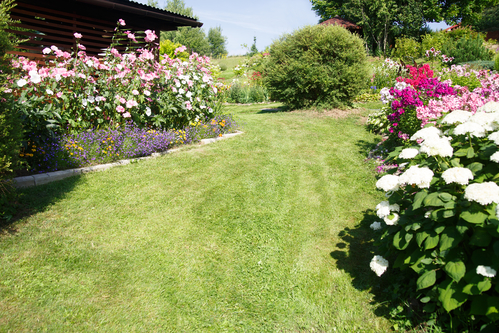
The best garden begins with the selection of the right plants to complement your landscape design and practical needs. In general, the first issue that you should consider when choosing your flora is the purpose of the garden. This space can be used to grow ornamental plants for aesthetic appeal. Alternatively, you can choose to grow edibles such as herbs and vegetables. If you are interested in both edibles and visual impact, it is possible to combine both types of plants.
The climate and environment is also an important consideration during the selection of plants for your garden. If you choose flowers, herbs or vegetables which cannot withstand growth in your local conditions, your garden will fail prematurely. It is advisable to choose indigenous plants because they grow naturally without the need for constant care. You can conduct research on the flora that grows in California for the best decisions.
Define the Boundaries
Boundaries are essential elements in garden design. If your garden does not have clear edges, your landscape will look like a wild land with plants growing haphazardly. Therefore, you must create distinct borders to define the perimeter of your garden and create order. If you would like to have a completely green landscape, consider using a hedge around your garden. For a more formal look, build a fence to isolate the space. It is also possible to edge the garden with stones. The stones will create a boundary without interfering with the visual effect of the garden.
Paths for Your Garden Design
Pathways are essential for a garden, especially one that experiences considerable foot traffic. The paths will allow smooth navigation around the space while protecting the landscape from the dangers of human carelessness. When designing your garden, you should think about the ideal places to form paths. You must also ensure that the path is wide enough for convenient use. To prevent the growth of plants on your pathways, consider installing a pavement or at least pouring gravel.
Borrow the Scenery
Gardens can be made more interesting by borrowing the scene from the surroundings. This borrowed scenery technique involves incorporating the view of a special feature into your garden. Simply speaking, this practice is about capturing the view beyond your own garden. For instance, you can trim the trees in your garden to reveal a distant building, your neighbor’s orchard or a mountain. Though these elements will not be on your property, they will have an impact on the aesthetics.
Enjoy Your Garden
Finally, you should create a comfort zone in your garden to allow you and your guests to enjoy the natural appeal of the space. For instance, a garden bench in a secluded spot might be perfect for settling and reading. A patio bordering the garden might be what you need for entertaining guests.
If you are interested in learning more about garden design, consult our landscaping experts for customized advice and guidance.
![]()
Backyard Ideas: Follow these Steps for Excellent Xeriscaping
Landscaping is great for the air quality around your home, and the curb appeal. However, many people complain that sometimes, it comes at an extremely high cost. One of the costs which are part of landscaping is water expenditure. Xeriscaping is an alternative to landscaping where the least possible amount of water is used. The beautiful thing about the process is that the quality of the resulting landscape will not be compromised, but a lot of water will be saved. Here, are some of the best backyard ideas on Xeriscaping which you need to try out.
Take note of problem areas
The start of any watering process should be to have a look at all the parts of the yard, and notice the ones which are easy to water, and also those which are extremely difficult to maintain. Steep slopes are usually the most prone to drought. After mapping out these areas, decide whether you want to keep their vegetation cover or not. If you decide that you want the vegetation cover, convert into perennial crops which do not need a lot of watering to stay alive and healthy, especially in the hot season. You might also want to consider drip irrigation to maintain these parts of the lawn.
Manage the size of the backyard garden
Another reason a lot of water gets wasted in irrigation is when the garden has an irregular shape. To combat this, you have to reshape the garden to create shapes which are easy to irrigate. You also need to replace the plants with xeric alternatives such as blue grass and buffalo grass, both of which take wear and tear very well. Buffalo grass can survive on less water; however, it has a low tolerance to interferences such as foot traffic, which makes it best suited for parts of the lawn that will not have a lot of traffic. Section off parts of the garden that are used less often, and turn them into shrub borders and flower gardens, that need less water to thrive.
You can also section off parts of the garden and make them into paths. You can line these paths with stepping stones of flagstones, which is good because it reduces the total surface area which has to be covered with lawn grass. Another tip which will be successful is transforming the rocky parts of the garden into a rock garden. You can use a variety of colorful rocks for the garden and use appropriate rock garden designs. There is a variety of crops which you can add to the rock garden.
Picking the right plants
The best plants for backyard ideas in xeriscaping are native and drought tolerant plants. Remember that xeriscape gardens are created in such a way that they fit Mediterranean and Southwest styles in gardening. You can consult with a landscaping expert to figure out the plants which will be most appropriate for your climate and locality.
When Xeriscaping is planned for and done properly, it produces some of the best gardens. It capitalizes on preserving native plants while at the same time reducing the amount of water used in gardening, and giving the regular landscape of your backyard a special touch. When you involve a competent landscaping expert in the process, the outcome will be amazing.
Four Creative Flower Bed Ideas to Get You Going
Creating sensuous textures and adding color to your garden with a flower bed is one of the quickest ways to improve your yard. And when it comes to flower bed ideas, there’s virtually no limit.
Raised flower beds are getting a lot of attention lately because they’re easier to water and maintain, but that’s far from the only option.
Other options are flower beds that encase trees and create a truly picturesque effect, flower beds that line a walkway to a backyard oasis, and tall flower beds filled with azaleas and wisterias.
Flower Beds Encasing Trees
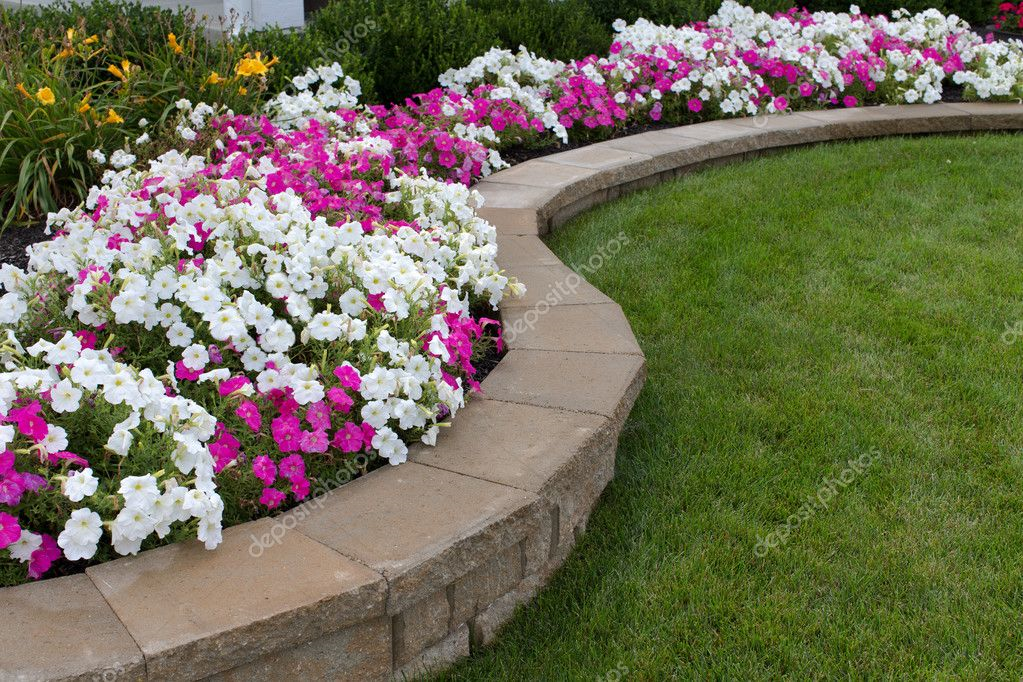
The thing to do when planting flower beds around trees is make sure that you’re selecting the right flowers for your particular region and getting the amount of sunlight versus shading right.
Plants and flowers that are “full sun” are the easiest to work with since they can receive six hours or more of sunshine per day and still be fine.
Yarrow, tickseed, and blanket flowers are all full sun plants that go great around trees. Lavender (purple) and sasha sage (white) pair well together and are both full sun plants. These might well give you the effect you’re looking for.
Circular Flower Beds
If you’re feeling a bit more adventurous, then you might want to consider a few of the flower bed ideas below (including this one!).
Circular flower beds are good if you have a huge tree that you want to draw attention to or a bare spot in your yard that needs a bit more color.
Taking an eclectic approach that gives you a wide palette of color is usually the way to go when it comes to creating a successful circular flower bed.
Bulbs, annuals, and perennials with a nice border flower like garanium can really frame things nicely. Putting something like a bird bath in the center is also an option.
Like these flower bed ideas but feeling overwhelmed with actually pulling them off? Get in touch with a landscaping company that can help you design, build, and maintain your flower bed for years to come.
Flower Beds Along a Walkway
As far as flower bed ideas go, this one’s right up there in popularity with raised flower beds and flower beds around trees.
Flower beds lining your walkway can significantly increase your curb appeal as a homeowner and work well with condos and receptions as well.
In terms of design, planting decorative flowers as a border along your walkway is said to soften the sameness and artificiality of concrete.
A line of flowers adds an unexpected splash of color in an unlikely, though not unwelcome, place.
Landscaping and design experts say to go with flowers that are hardy yet vibrant like mahogany bugleweed (purple) or red ruby.
A landscaping company can plan, edge, and till around your walkway to get things started on the right foot. Composting, mounding the soil, and actually planting the flowers comes next.
Here too landscapers can provide regular maintenance and put your flower bed and lawn on the irrigation and aeration schedule that both need to flourish and bring your outdoor landscape into full color.
Slanted Flower Beds
Slanted flower beds are one of those creative flower bed ideas that’s certainly not right for everyone but could be perfect for many people.
If your front yard is pitched, for instance, a landscaping team can help you raise your dirt bed to level and create a retaining wall that maximizes your flowers’ blooms while minimizing soil compaction.
Grasses and succulents are smart choices for sloped gardens. Contact a professional landscaper to make it happen!
There’s More to Landscape Maintenance Than You Might Think
Landscape maintenance is all about keeping your yard and garden attractive, safe, and healthy. That means keeping the bugs, insects, and other pests away and making sure that everything is cut and trimmed to keep your home or business landscape looking wonderful.
Getting on a regular landscape maintenance schedule might even be a good idea since it means less time spent pruning and weeding and more time spent with your family.
Professional landscapers can also handle the hard stuff like topsoil enrichment and making sure your lawn is on the right irrigation schedule.
Landscape Maintenance: Where Art and Science Meet
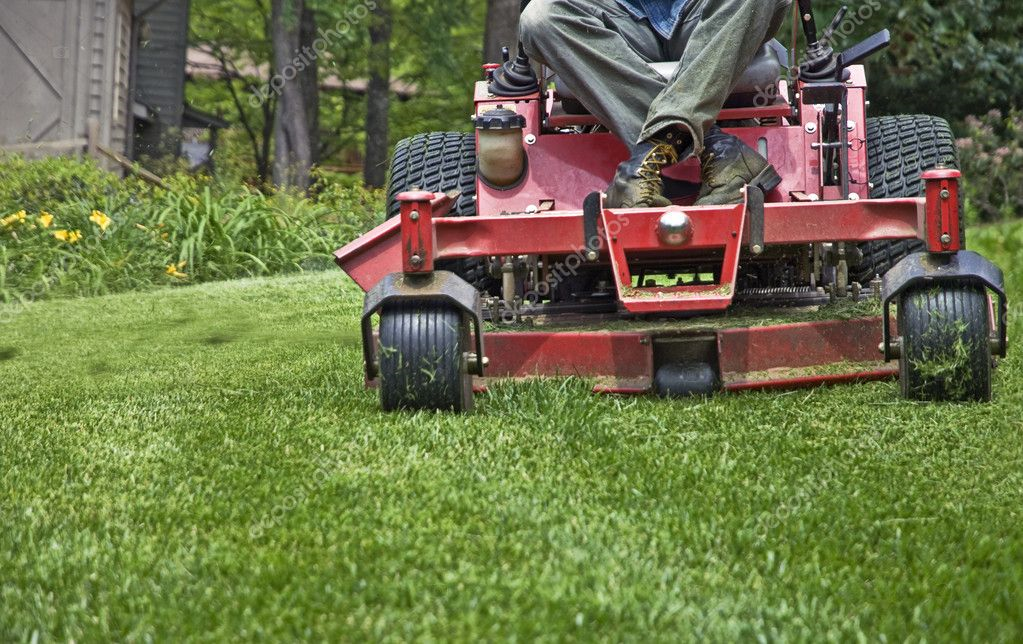
Professional landscaping is as much an art as a science. There’s a real science to, for instance, getting the pH balance of your lawn just right for growing plants, shrubs and flowers.
(Most grass likes a pH of about 7, though some warm-season grasses like more acidic soil with a pH of around 5. Don’t worry: The pros can tell you what’s right for your lawn!).
Now, one of the more scientific aspects of lawn maintenance is lawn aeration where your soil is perforated to allow in more water and the kinds of nutrients that your soil needs to perform at its best.
These tiny holes that are made when you have your lawn aerated also help get more air into the soil and help you avoid soil compaction. (That’s something you don’t want at all since soil compaction can negatively affect nutrient absorption and root growth.)
There’s as much art to landscape maintenance, though, since landscapers have to balance the layout, lighting, walkway access, and fencing of your yard with choosing and maintaining just the right bushes and mulch for your particular landscape.
Choosing the right kind of mulch – whether that’s straw, chips, stone, or bark – is important for making your garden and overall landscape look fantastic.
Mulching can also help prevent your garden from being ensnared by a bunch of weeds and ensure that soil compaction doesn’t become an issue for your lawn and garden.
The right kind of mulch can frame your landscape beautifully, promote nutrient absorption, and limit water use since more moisture gets to the roots.
Who Can Benefit from Regular Landscape Maintenance?
Because landscape maintenance covers so much ground almost any homeowner or business can reap the benefits. Condos, gated communities, shopping centers, community centers, banks, universities. You name it.
Any business that has a landscape that they want to protect and any homeowner that wants to improve their curb appeal should seriously consider getting on a regular landscape schedule.
So, do you currently need to be experiencing lawn issues to hire a landscaper? Not necessarily, but landscape maintenance includes things like fertilizing and spot treatments to address those pesky bald spots on your lawn.
Uprooting weeds is another thing that most homeowners don’t exactly look forward to doing but that can have a big payoff when it comes to keeping your lawn healthy and beautiful.
When you get on a regular landscape maintenance schedule you can have weeding, aeration, mowing and mulching taken care of.
Knowing that you’re doing the most to improve the curb appeal of your home or the attractiveness of your business property lends a huge amount of confidence that’s sure to spill over.
A professional landscaping company will even provide monthly irrigation inspections to ensure your yard, garden, shrubs, and bushes are getting the nourishment they need. You can also have your lawn pH tested to take the guesswork out of it.
Contact us to discover all of the amazing benefits of getting on a regular landscape maintenance schedule.
Ways To Master Your Summer Lawn Care
Here are the Top 5 tips For Summer Lawn Care that can help you to achieve the best lawn.
- Starting Over – Cleaning Up –
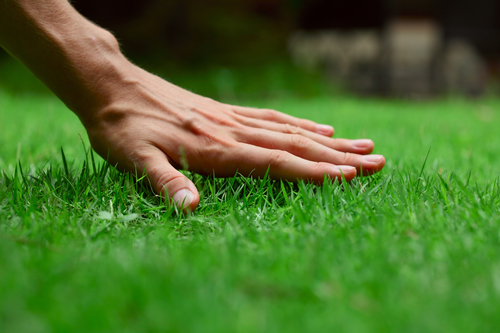
The first thing you should start by doing is walking over your lawn and gather branches, twigs, leaves and any other debris that has accumulated and dispose of. (Or it can be thrown in the compost bin to later be used as mulch)
Cleaning up your lawn area should also include raking up any matted areas of the lawn which can encourage snow mold. Not only does this help to prevent any disease or insect infestation but at the same time it promotes better air flow throughout the turf and allows new grass blades to grow without difficulty.
- Protect Your Interest – Weed Control –
Weeds can definitely be a gardener’s worst nightmare and no matter how you try to get rid of them they keep coming back. Though you may not be able to stop them completely there are things you can do to keep them at bay. Weed control.
As part of your lawn care, it is very important to carry out weed control – applying an effective weed killer whether it be organic or inorganic before temperatures hit 55-60 degrees. If you wait until temperatures reach this point, conducting weed control will be pointless as weed seeds would have already begun to germinate.
- Kick Start Growth – Fertilizing –
Winter really signifies a dormant period for gardens and landscapes as your lawn and other areas tend to go into a slumber, however, fertilizing your lawn and other garden areas in the spring gives it a much-needed jumpstart.
This provides an intensified nutrient build up that will give your lawn and other areas the strength they require to withstand the heat and drought that follow in the summer months.
- Let It Breathe – Core Aeration
Just like weed control, it is important to core aerate lawns in the spring as part of your lawn care, before soil temperatures reach 55-60 degrees since this encourages aggressive weeds to populate void spaces in a lawn. Allowing water and air to reach root zones easily, core aeration is great for lawns and helps gardeners to quickly achieve new growth when they apply this useful tip.
- Repair And Rejuvenate Lawns – Re-Seeding Turf
Nine times out of ten winter will wreck havoc on your lawn and come spring the damage is done. Now what? Well, as long as the weather permits it how about doing some re-seeding?
This is a great technique gardeners can use to restore damaged areas of their lawns, however, it may be a bit tricky if you’re applying a pre-emergent weed control so it must be carefully done.
You see, pre-emergent weed control isn’t selective, meaning it will prevent ANY seed from germinating including those used to reseed your turf.
Usually, it’s recommended to hold off weed control to the latest point possible an to perform the turf repairs needed as early as possible so that the seeds have enough time to germinate and become established before weed killer is applied. If this is not possible, don’t skip your weed control instead wait until fall to perform any turf repairs necessary.
Bonus Tips For Lawn Care
- Mow Turf On A High Setting – You should adjust your mower to cut your lawn grass at the highest possible setting. Most turf types usually thrive better when blade heights are about 3 to 4 inches tall.
- When mowing Zoysia grass and Centipede grass, use the lowest setting. For Bermuda grass and creeping bentgrass, it’s best to remove only a third of the total grass blade length at a time.
- Applying mulch – Mulches help to provide essential nutrients and help with weed prevention and soil stability all season long be sure to apply some where necessary.
Contact the experts here at DK Landscaping – our expert team is on call to come in and assist you with any lawn care or gardening task that you have.
Give us a call at (707) 280-3632 or you can visit our website at dklandscaping.com for more information or book your appointment.
Top 5 Sizzling Summer Landscape Design Ideas For 2018
“ I Go To Nature To Be Soothed, And Healed And To Have My Senses Put In Order.”
-John Burroughs
Ready to try something new this summer in your garden? Well, if you’re looking for hot, exciting, ideas you can use to spice up your landscape and make it stand out then you’ve definitely tuned into the right station. Whether you want to transform your outdoor space into a head-turning, masterpiece of nature or you simply want to spend your time outdoors among beautiful trees and flowers, we’ve got the ideas that can help you achieve it. Without further delay, let’s get straight down to business and have a look at 5 Top Summer Landscape Design Trends that have been taking the outdoors by storm.
- Revamping Lawn Areas

Have you ever noticed how a well-trimmed and maintained lawn has become a popular attribute that represents everything about the quiet suburban life?
Despite this, droughts, water shortages and rising environmental challenges in recent years have seemed to take their toll on many landscape designs including lawn areas. Nevertheless, instead of going with a traditional type lawn this summer people could consider planting grass mixes that don’t require mowing.
- Go Bold This Summer With A Colored Fence
This is probably one of the easiest, most cost-effective ways to enhance your landscape design and it not only sets the tone but really adds a certain highlight to the outdoor space.
A little color always makes things a bit more interesting – Add a slice of drama to your garden since the landscape design trends for this summer, dictate that using dark and bold colors for outdoor structures can give your landscape that extra boost and more for the eyes to feast on.
This should be a welcomed change from the traditional ‘white picket fence’ that has somehow gotten old.
- Natural Materials Add Texture Where Needed
In previous years when a more contemporary, landscape design concept reigned unopposed, it was one thing, but in more recent times, landscape designers have been getting more requests for the addition of natural elements and non-geometric styles, in order to exude a more natural and original landscape design.
Decks, swing seats, garden furniture, bird baths and small fountains all seem to be returning to the top of the list of trending ideas for summer landscape designs.
- Sustainable Watering Ideas To Match Environmental Conditions
With recent drought conditions showing no sign of letting up, keeping landscape designs in good shape has been proving to be a bit challenging for landscapers.
Since this is the case, this summer, why not jump onto the trend of low-water landscaping? Xeriscaping as it is more commonly referred to in landscaping circles is a landscape design that includes many drought-tolerant plant species that require little or no maintenance.
Not only does this form of landscape design help landscapers to promote water conservation in harsh times but they don’t have to spend so much time maintaining landscapes.
- Dog-Friendly Landscape Designs Are Great For Accommodating Your Pet
Most people who are dog owners are aware that dogs like to dig, so when planning your summer landscape design why not apply a few dog-friendly tips that you can not only have a beautiful landscape but a happy dog as well.
By making special areas throughout your outdoor space like sandboxes, for your dog to carry out its instinctual habit of digging, is a great way to avoid damage to your precious blooms while keeping your dog happy.
With Spring is reaching its zenith, landscapers everywhere are already into summer gardening mode. So, before you start pulling, raking and sowing, why not consider these summer trends to enhance and complement your landscape design.
If you need help with your landscape design or to start one from scratch, we’re here to help. The experts here at DK Landscaping have been helping gardeners all across California achieve the landscape design of their dreams.
Call us today at (707) 280-3632 to get started right away or you can visit our website at dklandscaping.com to learn more.
How To Make Your Summer Landscape Design Stand Out
“The Poetry Of Earth Is Never Dead” – John Keats
Choosing plants for a Spring landscape can be pretty straightforward since many species thrive well this time of year, which is good, but if you’ve decided to switch things up and go for a summer landscape design instead, here’s how you do it.
When planning your summer landscape design you want to create the perfect mix of blooms that not only show resilience to heat but also make your landscape explode with life.
Well, here are a few insightful landscape design ideas that can help you to achieve the perfect landscape design this summer.
Use Heat-Tolerant Blooms in Landscape Designs to Beat the Heat
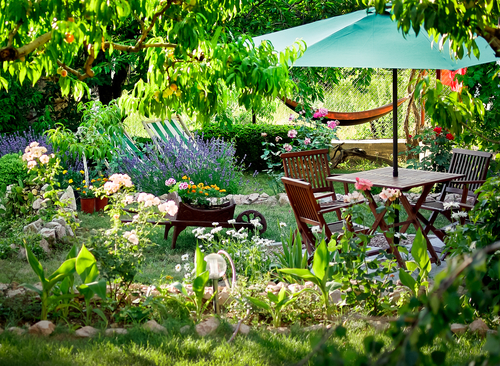
Various blooms can be damaged or destroyed in high temperatures so it is recommended that you use sun-loving plants that show exceptional resilience in heated conditions. Plants that can be planted in or before summer that thrive well in high temperatures can add a fresh and vibrant look to your landscape without compromise. Include heat-tolerant, summer-blooming plants like Zinnias, Verbenas, Latanas and Mealycup Sage in your garden.
Bring Your Landscape Design to Life with Lots of Color
Bring excitement and energy to your landscape design with bright and bold colors. Here are some great ideas you can use.
Opting to use species like Portulaca, a heavy blooming succulent, works well as a border in the landscape or “spiller” in your containers. Found in an array of colors such as white, orange and yellow while embraced by succulent foliage, this species is great for hot conditions and adds a bright, bold color combination to warm sun-kissed landscapes.
You can even go exotic by planting a little bit of every color or you can pair Portulaca with other sun-loving annuals or herbs such as pineapple sage, gomphrena or upright rosemary.
Add Variety and Contrasting Features with a Mixture of Color and Texture
You can pair plants together in order to create texture and to display color in any summer landscape design. You can even take things a step further by vamping up your foliage color with a bit of golden oregano mixed with varieties like ornamental peppers in yellow, orange or red.
Creating a kaleidoscope of colors contrasted by the velvety foliage of succulents adds an extraordinary texture and variety to your landscape and the best thing about them is they stay beautiful all summer long.
Make A Statement With Architectural & Modern Landscape Design Ideas
It’s not only the colorful, heat-loving blooms that make up the perfect summer landscape design but other important elements as well.
After planting your blooms and setting things in motion you want to put the finishing touches on your landscape design. Below are a few popular ideas that help you to put the icing on the cake by adding a contemporary flair to your surroundings while giving your landscape design that extra edge.
- Mulching – Provides additional color throughout the landscape and helps plants retain moisture.
- Fountains, bird-baths, garden furniture and stylish plant containers give a stylish effect that complements the entire landscape design.
- If none, adding certain hardscape features like, steps and walkways serves to accommodate traffic while adding extra appeal.
- Garden lights – Help to light walkways and give landscapes a certain ambiance at night.
Keep Landscape Designs and Regular Maintenance
Watering, pruning, deadheading and mulching are perfect ways to keep landscapes healthy and in superb shape. Supplementing landscapes with water up to twice per week or as needed is also very important – especially for containers and new color plantings. If you don’t have the time to water plants then perhaps installing an irrigation system can serve to supply water to landscapes in a timely manner without them being neglected or drying out.
Mowing, edging, raking and forking soil every now and then can also serve to keep landscapes clean and aerated while maintaining their appeal. If you need help establishing your summer landscape design, the experts here at DK Landscaping are here to help. Give us a call at (707) 280-3632 we install irrigation systems, design xeriscapes and hardscapes and offer landscape maintenance services.
For more information or to book an appointment you can visit our website at www.dklandscaping.com
Don’t sit there- Get started with your summer landscape today. Do you have a special design in mind?


